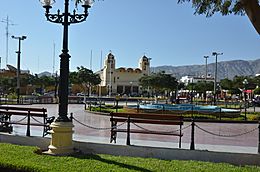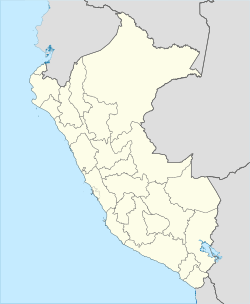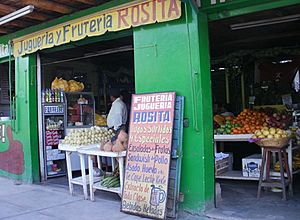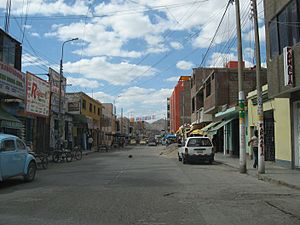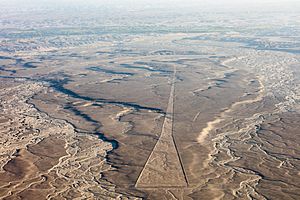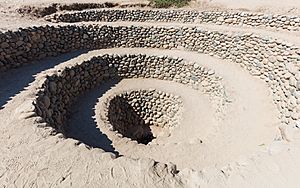Nazca facts for kids
Quick facts for kids
Nazca
|
||
|---|---|---|
|
||
| Country | ||
| Region | Ica | |
| Province | Nazca | |
| Founded | 17 November 1591 | |
| Elevation | 520 m (1,710 ft) | |
| Population | ||
| • Estimate
(2015)
|
39,054 | |
Nazca (pronounced like NAHZ-kah) is a city in Peru, located on the southern coast. It is sometimes spelled Nasca. The city of Nazca is the biggest in the Nazca Province.
The city gets its name from the ancient Nazca culture. This amazing culture thrived in the area between 100 BC and AD 800. They are famous for creating the mysterious Nazca Lines and building the special city of Cahuachi. The Nazca people also built clever underground water channels called aqueducts, known as puquios. These channels still work today! Some people think the very first puquios were built by an even older group, the Paracas culture.
Nazca is the main city of the Nazca Province. It is part of the Ica District in the Ica Region of Peru.
Contents
Major Events in Nazca
The 1996 Earthquake
On November 12, 1996, a big earthquake hit Nazca. It happened at 11:59 a.m. local time and had a strength of 7.5. The earthquake's center was about 7.7 kilometers out in the sea.
This powerful earthquake almost completely destroyed the city of Nazca and the areas around it. Luckily, because it happened during the day, only 14 people died. However, about 1,500 people were hurt, and around 100,000 people lost their homes.
Even with all that damage, Nazca was almost completely rebuilt within 12 years.
Mining in Nazca
Since 1997, a large Canadian company has been mining for gold in Nazca. At that time, the local people did not legally own their traditional lands. Because of this, they had to move away from their homes. Since then, they have been working to get their ancient land ownership recognized by law.
Nazca's Environment
Climate and Weather
Nazca is one of the driest places on Earth. It gets only about 4 millimeters of rain each year. The weather in Nazca is greatly affected by the Humboldt Current. This ocean current brings cold water from Antarctica up the west coast of South America.
The cold ocean water cools the air above it. This makes it hard for clouds to hold much moisture. So, even though you might see clouds and fog, there is very little rain.
Temperatures in Nazca usually range from 10 to 32 degrees Celsius (50 to 90 degrees Fahrenheit). The average high temperature each day is about 21 degrees Celsius (70 degrees Fahrenheit).
- Summer (November to March): These months are dry, sunny, and hot.
- Winter (June to August): During winter, fog from the coast often rolls over the hills. This keeps temperatures moderate. However, the strong sun can make the daytime feel hotter than it is.
| Climate data for Nazca | |||||||||||||
|---|---|---|---|---|---|---|---|---|---|---|---|---|---|
| Month | Jan | Feb | Mar | Apr | May | Jun | Jul | Aug | Sep | Oct | Nov | Dec | Year |
| Mean daily maximum °C (°F) | 31.8 (89.2) |
32.4 (90.3) |
32.6 (90.7) |
31.6 (88.9) |
29.9 (85.8) |
27.6 (81.7) |
27.0 (80.6) |
28.2 (82.8) |
29.7 (85.5) |
31.1 (88.0) |
31.5 (88.7) |
31.8 (89.2) |
30.4 (86.7) |
| Mean daily minimum °C (°F) | 17.5 (63.5) |
18.1 (64.6) |
17.2 (63.0) |
15.6 (60.1) |
11.3 (52.3) |
8.1 (46.6) |
7.2 (45.0) |
7.9 (46.2) |
9.3 (48.7) |
11.5 (52.7) |
13.4 (56.1) |
15.9 (60.6) |
12.8 (55.0) |
| Average precipitation mm (inches) | 0.7 (0.03) |
0.8 (0.03) |
0.2 (0.01) |
0.0 (0.0) |
0.0 (0.0) |
0.0 (0.0) |
0.3 (0.01) |
0.0 (0.0) |
0.0 (0.0) |
0.0 (0.0) |
0.0 (0.0) |
0.1 (0.00) |
2.1 (0.08) |
| Source: SENAMHI | |||||||||||||
History of Nazca
There are two main stories about when the Spanish founded Nazca:
- Some old writings say the city was founded on October 28, 1548. This was ordered by Pedro de la Gasca, a Spanish official.
- Other accounts say it was founded in 1591 by Viceroy García Hurtado de Mendoza, 5th Marquis of Cañete.
Nazca in Colonial Times
During the time when Spain ruled Peru, Nazca was well-known for making wine and a strong grape drink called aguardiente de la uva. Today, this drink is often called pisco, named after a famous port. In Nazca, people still call their local version Nasca. These drinks were sold widely across Peru and even further away.
The biggest vineyards (grape farms) in Nazca were in the rich Ingenio Valley. These farms belonged to the Society of Jesus, also known as the Jesuits, who were a group of Catholic priests and missionaries.
- The hacienda (large estate) San Joseph de la Nasca was owned by the Jesuit College of Cuzco.
- The hacienda San Francisco Xavier de la Nasca was owned by the Jesuit College of San Pablo in Lima.
Both of these estates used many workers who were enslaved people brought from Africa. Besides making wine and brandy, these estates also had special places to make ceramic jars called botijas. These jars were used to transport the wine and brandy.
Today, the towns of San Javier and San José have the ruins of large churches from the 1700s. These churches were built when the Jesuits managed the estates. In 1767, King Charles III of Spain ordered the Jesuits to leave. The Spanish Crown then took over these properties.
Nazca and Independence
On October 14, 1820, people in Nazca who wanted independence welcomed General Don Jose de San Martin and his army. This happened after they escaped from the Battle of Nasca.
Two days earlier, on October 12, General Juan Antonio Álvarez de Arenales was sent to chase after the royal troops (Spanish army) who were running away from Ica. An Argentine officer, Lieutenant Colonel Manuel Rojas Argerich, led 250 men.
The town of Nasca was officially created on August 29, 1821. It became a district on July 2, 1855, and then a province on January 23, 1941.
Even today, Nazca has a very dry climate. Before and during the time of the Inca Empire, the area had a very advanced water system. Water was collected through underground tunnels called filtration galleries. The openings to these tunnels were called puquios. More than 36 of these puquios still work today. They help water farms and provide water for people's homes.
The Nazca Lines
The Nazca culture is very famous for its amazing drawings in the desert, known as the Nazca Lines. These lines were made by a well-organized society between 500 BC and AD 500.
Many people think you can only see the lines and figures from an airplane. However, you can also see them from nearby hills and other high places. There are countless shapes, including both animals and geometric designs.
Local tour companies offer flights over the Nazca Lines. These flights usually show about 12 main figures. The most famous ones are the hummingbird, the condor, and the monkey. The spiral tail of the monkey even inspired the spiral shape in the "P" of Peru's national logo, which you can also see on their money!
UNESCO declared the Nazca Lines a World Heritage Site in 1994. This means they are very important to the world and need to be protected.
Nazca's Airport
Nazca has a small airport called the Maria Reiche Neuman Airport. It is mostly used for tourist flights that go over the Nazca Lines. The airport is named after Maria Reiche, a woman who spent many years studying the Nazca Lines. She helped bring them to the world's attention as amazing creations by ancient people.
Famous People from Nazca
- Martina Portocarrero (1949-2022): She was a folk singer, someone who studied culture, and a politician.
See also
 In Spanish: Nazca para niños
In Spanish: Nazca para niños


